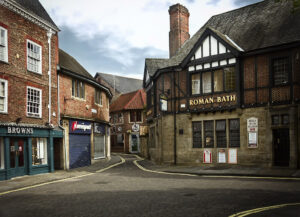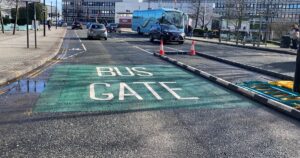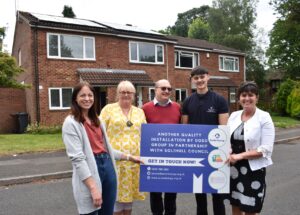Opinion: What we learned from Liverpool City Region’s first Active Travel Summit
Huw Jenkins, Transport and Air Quality Policy Lead at Liverpool City Region Combined Authority, shares with Air Quality News what was discussed at Liverpool City Region’s first Active Travel Summit and considers why it’s important we encourage active travel.
Active travel can be one of those subjects where the public conversation generates more heat than light. But we know that encouraging more people to walk and cycle, particularly for short journeys, is going to be vital to improving the environment, air quality and the health and wellbeing of everyone who lives and works in the Liverpool City Region.
That’s why, earlier this summer, Mayor Steve Rotheram hosted what we hope will be the first of many Active Travel Summits in the Liverpool City Region. The event brought together policymakers, local community organisations and advocacy groups to share knowledge and experience and to discuss the future of walking and cycling in the region.
Speakers at the event included Chris Boardman MBE, Olympic gold medal winning cyclist and new Commissioner for Active Travel England, and Rosslyn Colderley, Northern Director of sustainable transport charity Sustrans.
Also taking part in the event were grassroots campaigners from across our region including Ibe Hayter, founder of Cycle of Life – an organisation based in Toxteth which aims to support cycling within the local community, providing access to bikes and cycle repairs for local people from low income households.
Faced with a growing climate emergency, Liverpool City Region pledged to become zero carbon by 2040 and Mayor Rotheram has committed to driving forward with a major programme of green investment. But with more and more journeys taken by car every year, it’s clear travel habits in the region need to change.
Motor traffic is the biggest cause of air pollution in the Liverpool City Region and while domestic and business carbon dioxide emissions here are steadily falling, transport emissions have risen since 2013 and this is mostly down to increased car use.

It is estimated poor air quality in the city region kills around 800 people every year and it aggravates health conditions such as asthma, COPD and fibromyalgia.
We also know that poor air quality disproportionally affects lower income communities, who are more frequently exposed to pollution both at work and at home, adding a major social fairness dimension to the issue.
The effects of carbon emissions and poor air quality are really clear, and so is the solution: we need to get people out of their cars and taking more trips, on public transport and by bike or on foot, and we’ll only be able to do this by making active travel safe, easy and accessible.
According to our own research, if everyone across the Liverpool City Region could swap two car trips a week – to the local shops, to work or school or even to the train station or bus stop as part of a longer journey – for a walk or bike ride, it could reduce carbon emissions by around 130,000 tons. That’s the same amount produced by a town of around 30,000 people in a year.
One particular highlight of the summit was the screening of a new film produced with our Walking and Cycling Commissioner, and BAFTA-winning actor and presenter, Simon O’Brien. A lifelong active travel advocate, Simon uses the film to explore some of the best quality walking and cycling routes in the country and details the positive impact this new infrastructure is having on health, the local economy and environment in these areas.
Only moments from where the event was hosted, at the Combined Authority’s offices at Mann Island, Liverpool, is the Strand, one the city’s main thoroughfares which has recently been upgraded with new best-in-class segregated walking and cycling routes.
The route is just a small section of a planned 600km active travel network which will cover all six boroughs of the Liverpool City Region – Halton, Knowsley, Liverpool, Sefton, St Helens and Wirral. To date more than £30m has been committed to building safe and separate footpaths and cycle lanes.
Mayor Rotheram used his address at the summit to announce that an additional £12m had been secured from Department for Transport’s Active Travel Fund to build high-quality walking and cycling routes across the city region.
The funding will also help to deliver School Streets schemes – which reduce traffic congestion and pollution at school gates during pick up and drop off times – as well as low traffic ‘Liveable Neighbourhoods’, which recent research from Sustrans showed were supported by 69% of people in the city region.
There will also be a ‘mini-Holland’ feasibility study to assess how parts of the region can be made as pedestrian and cycle-friendly as similar neighbourhoods in Dutch towns and cities.
By introducing traffic calming measures in the form of useable street furniture like planters or benches, these schemes will prioritise walking and cycling over motor traffic and help make neighbourhoods into safe and pleasant places to live, work and spend leisure time.
The newly announced funding comes in addition to more than £200m from the City Region Sustainable Transport Settlement (CRSTS) committed to delivering highway upgrades, from carriageway resurfacing works to streetlights, that will support the improvement of cycling and walking routes.
This pushes the total amount of funding for the Liverpool City Region’s active travel network close to a quarter of a billion pounds – a serious level of investment that will help to put walking and cycling on a par with other parts of the local transport system like rail or bus.
As this year’s Active Travel Summit drew to a close, delegates gathered to discuss the event and I was extremely heartened to hear that so many of those who had attended felt energised and optimistic about the future of walking and cycling in the Liverpool City Region. The challenge facing us is clear – we have to work hard and at serious pace to build a better active travel network, to help and support people in travelling actively.
Mayor Rotheram and all of us at the Combined Authority are committed to making the Liverpool City Region the best place to walk and cycle in the country and we will keep working with everyone – whether in government, local authorities or community organisation – to make this a reality.
You can watch Liverpool City Region Cycling & Walking Commissioner Simon O’Brien’s video on active travel schemes here.
Photos provided by Liverpool City Region Combined Authority and Laurie Byrne

















